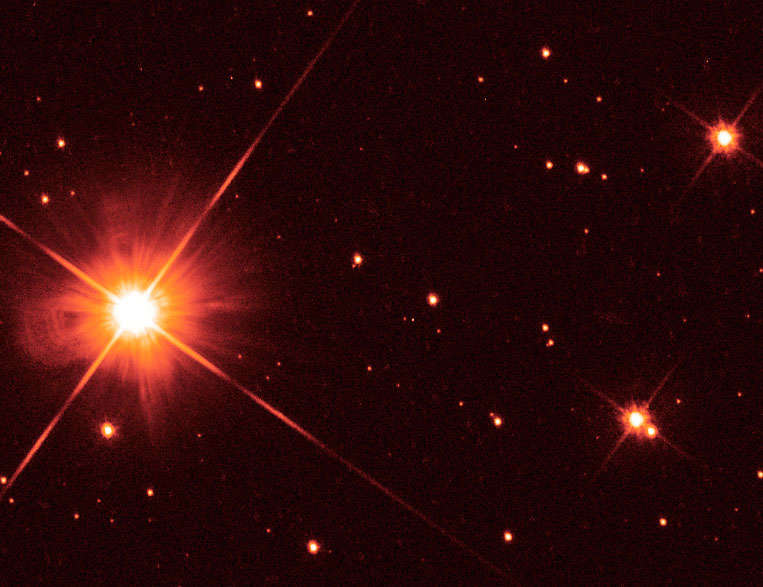Create a free profile to get unlimited access to exclusive videos, sweepstakes, and more!
How Proxima Centauri’s mega-flare could change our minds about star tantrums and aliens

For seven seconds in 2019, the nearest star to the Sun lost its temper in what was the hugest stellar flare ever. Now observations made by the nine telescopes that witnessed have scientists questioning what they thought about flares and habitable zones.
Proxima Centauri was that star. In what was the most enormous stellar flare ever observed, it suddenly flashed 14,000 times brighter and belched out so much ultraviolet and millimeter (radio) radiation that the lack of visible light hardly mattered. It also proved that stars are able to flare in the millimeter range. Astrophysicist Meredith MacGregor of CU Boulder, who led a study recently published in The Astrophysical Journal, had admittedly never seen anything like it because nothing had ever led scientists on that a star was capable of flaring in the millimeter range before.
“Flares occur when magnetic field lines in the star twist and snap, releasing radiation and accelerating electrons and charged particles outwards,” MacGregor told SYFY WIRE. “The properties of the millimeter emission indicated that it was directly tracing those accelerated electrons. Because millimeter and UV emissions traced each other so closely, it might mean that millimeter observations could tell us about the limits of the UV environment of stars and exoplanets."
Though Proxima Centauri is a red dwarf only a fraction the size of our Sun, its deceptively small size doesn’t mean it can’t generate the rush of radiation that MacGregor and her colleagues caught multi-wavelength coverage of. Seeing the flare in various wavelengths gave them the opportunity to compare wavelength timing and energy. It also told them what the radiation was being produced by and where it was coming from. Visible light probably came from deeper in the star’s atmosphere, which can explain why there was not nearly as much as other types of light; it took longer for it to be emitted into space.
Monster flares like this happen often on stars like Proxima, and red dwarves are some of the most common stars in the universe. This observation could open the portal to some extremely weird physics that had never even been thought of before. Because red dwarfs are so faint, it can be difficult for telescopes to see exactly what is going on, and their tendency to break out in such intense flares so regularly could mean a shift in what are assumed to be habitable zones. Proxima b, which orbits Proxima Centauri, was previously thought to have a chance at being habitable, but MacGregor believes its star’s violent flaring behavior has called that into question.
“Because flares of this size are incredibly common on stars like Proxima, that has some big implications for the possibility that Proxima b is a habitable planet,” she said. “We now really need to do work like this for many more stars, expand the sample so that we can better understand the habitability of planets in red dwarf systems.”
Earthlike planets could never survive in a situtation like Proxima b’s. If Earth was swapped out with Proxima b for an orbit, its atmosphere would be singed away, the water dried up in no time, and life extinguished. So much for the so-called “habitable zone” of Proxima Centauri.
There is one radiation-blasted planet that could possibly shed light on whether Proxima b—or anything else that could be orbiting Proxima Centauri—could have the potential for sustaining life. Nothing that we know of lives on the surface of Mars. It is thought to have once been a much more bearable planet for life (at least as we know it), with flowing water where life could have spawned, but not so much after its atmosphere was annihilated. Attack by UV rays is partly to blame for turning Mars into a barren planet. Proxima b also has a UV problem even though it is being mercilessly scorched by stellar flares while Mars is a freezing desert.
Mars and Proxima b take a beating from some of the same deadly forces. If the similarities and differences between these forces and other planetary conditions are analyzed, Mars could help scientists at least hypothesize about Proxima b’s potential for life. Whatever Perseverance digs up from beneath the Martian surface could reveal even more. Whether life could survive, or ever could have survived in the Martian underground might give us some idea about the subsurface of Proxima b.
“UV radiation from flares like this could strip away the planet's atmosphere, and damage the DNA of life-forms on the surface,” MacGregor said. “If flares like this happen daily, it is hard to imagine that life like that on Earth would be able to survive. Any life on Proxima b would have had to evolve to be able to handle continual large doses of UV radiation, and look very different from anything we are familiar with.”
If there does turn out to be life on Proxima b, alive or fossilized, we might not even recognize it, but this planet and its star are only the beginning of a new frontier.



























